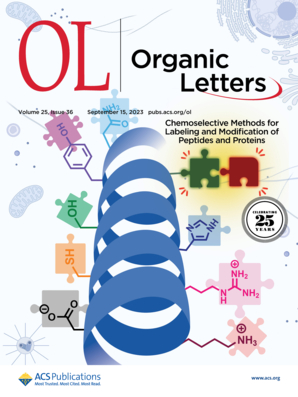tempo介导的四氢异喹啉类化合物α-烯丙基化反应
IF 4.9
1区 化学
Q1 CHEMISTRY, ORGANIC
引用次数: 0
摘要
四氢异喹啉类化合物的C(sp3) -H烯丙基化反应是由Shono氧化与曼尼奇型反应相结合而形成的。采用TEMPO作为电催化剂,降低电极电位,提高官能团相容性。该方法为四氢异喹啉类化合物α-烯丙基化反应提供了一种实用高效的串联反应方法。反应的过程是通过原位阳极氧化生成一种氨基阳离子中间体,然后是2-烯丙基环芳烃的亲核加成。本文章由计算机程序翻译,如有差异,请以英文原文为准。

TEMPO-Mediated Electrochemical α-Allylation of Tetrahydroisoquinolines
A C(sp3)–H allylation of tetrahydroisoquinolines has been developed by combining Shono oxidation with a vinylogous Mannich-type reaction. TEMPO was used as the electrocatalyst to lower the electrode potential, improving functional group compatibility. This method provided a practical and efficient tandem procedure for the α-allylation of tetrahydroisoquinolines. The reaction proceeded through the formation of an iminium cation intermediate, which was generated in situ by anodic oxidation, followed by nucleophilic addition of 2-allylazaarenes.
求助全文
通过发布文献求助,成功后即可免费获取论文全文。
去求助
来源期刊

Organic Letters
化学-有机化学
CiteScore
9.30
自引率
11.50%
发文量
1607
审稿时长
1.5 months
期刊介绍:
Organic Letters invites original reports of fundamental research in all branches of the theory and practice of organic, physical organic, organometallic,medicinal, and bioorganic chemistry. Organic Letters provides rapid disclosure of the key elements of significant studies that are of interest to a large portion of the organic community. In selecting manuscripts for publication, the Editors place emphasis on the originality, quality and wide interest of the work. Authors should provide enough background information to place the new disclosure in context and to justify the rapid publication format. Back-to-back Letters will be considered. Full details should be reserved for an Article, which should appear in due course.
 求助内容:
求助内容: 应助结果提醒方式:
应助结果提醒方式:


